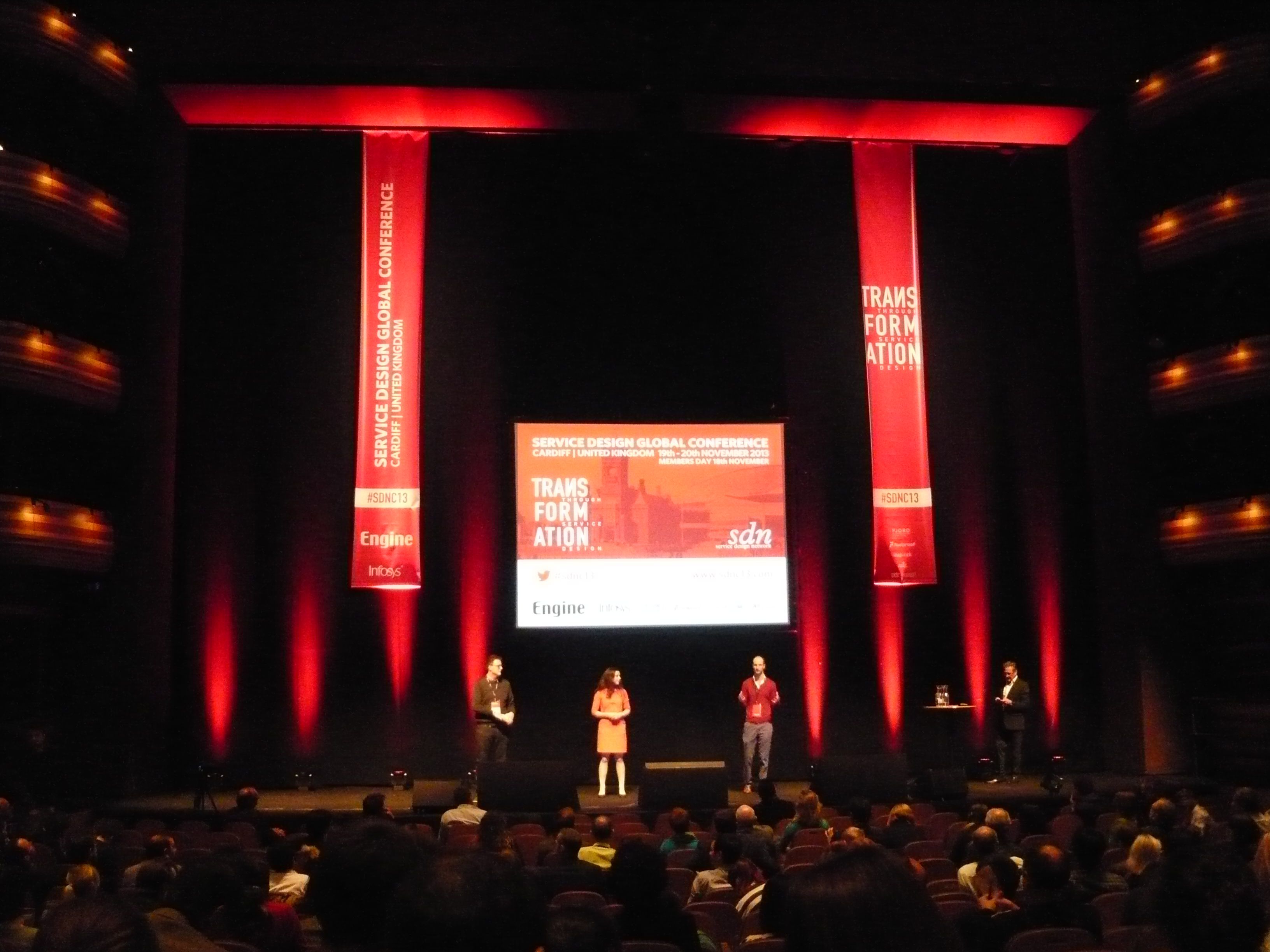Gastbeitrag über die Service Design Conference 2013 in Cardiff im Blog des MBA-Studiengangs Service Innovation and Design.
"Is service design more in love with the process than the outcome? Do we want to be defined by processes, or outcomes and impact?" Lee Sankley provoked the audience in the Wales Millenium Center last Tuesday.
Unlike the singers and dancers that usually take the impressive stage, Lee Sankley is group design director at finance company Barclays. He spoke to an audience of over 400 people who had gathered in Cardiff from November 18 to 20 to discuss the future of service design at the 6th Service Design Global Conference. For three days the Welsh capital was humming with a mix of over 50 talks and workshops, discussions, networking and drinking.
Big data and little dataData was a principal theme of the conference. Not few were surprised when Kerry Bodine of Forrester Research pointed out how much data every one of us produces daily. More than creating original content data is also produced by sharing details with providers, receiving information from organizations and recorded data such as search queries or credit scores. As more and more information gets digitalized and sensors capture different aspects of life, we face big data which is more than humans can process. Only a small fraction of this data is used. An excellent showcase for use of big data to drive actionable insights came from Maria José Jorda Garcia of BBVA. Commerce 360 lets shop owners compare their store performance to others in the same area or sector based on financial transactions. From these insights a number of new business ideas can be derived.
However, according to Kerry Bodine a majority of organizations find it difficult to handle unstructured data in large volumes. Furthermore, she emphasized the importance of qualitative data for an understanding of the underlying reasons. In some cases little data is even more valuable for less cost and often it goes hand-in-hand with big data. Quantitative data can serve to validate findings of qualitative research while attaching numbers and currency to deliverables can help to make the business case for service design. Erik Roscam Abbing of Zilver Innovation showed an example of a customer journey map that uses quantitative data to allocate where the biggest pain is.
On the second day, Marion Fröhlich and Mauro Rego shared a method for creating actionable data dashboards in an interactive workshop. Because the visible part of the service is a result of many steps in the background, they stressed the importance of streamlining the back office. SAP's innovative database system HANA supports decision making by putting relevant data at your fingertips in real time. SAP Design and Co-Innovation Center has developed a process that starts by analyzing roles and activities to determine which insights are most critical in key moments. After identifying the most relevant KPIs and triggers for action we got our hands on paper prototyping a sample dashboard.
Kerry Bodine warns that we are data illiterate and risk to draw the wrong conclusions from big data. She emphasizes the growing need to become fluent in big data and educate how data informs design.
In-house and externalBy now some organizations have built in-house teams trained in service design. Throughout the conference a number of speakers and participants argued in favor of internal service transformation. Still there is much work to do for external consultancies and as Graham Hill tweeted "Most Cos don't need in-house design." The role of external teams is mainly knowledge transfer and support. Being no longer needed marks their achievement. In this sense, the message rather was that designers need to become partners rather than heroes. Key to success is a larger degree of immersion into an organization down to details such as taking on their dress code and language.
A common perception is that external teams are good at pointing out potential for optimization and delivering concepts but companies are left alone with the larger part of implementation and day-to-day operation. As a result, initiatives run out of steam and little impact is produced. In a panel discussion the notion emerged that this is largely owed to current business models of consultancies. In order to become more than facilitators and to help bridge the reality gap for real impact, external consultancies will need to rethink their business models considering for instance subscription and outcome-based models.
Other companies such as BBVA heavily rely on open innovation and open platforms to fuel their internal team's efforts and marry the benefits from both approaches.
Small steps for great leaps forwardLydia Howland of IDEO introduced "real-time service design" as the concept of mixing service design with a startup mentality. "There is no substitute for an actual experience" and people behave differently in research. Building on trends such as popup stores and crowdfunding it can be fruitful to realize ideas in limited ways and observe and measure response in real-life context. She appeals not be be scared to get started for the sake of learning and ask for forgiveness, not permission. Lee Sankley agrees that the devil is no longer in the detail but in disruption.
As Andy Jones underlined from his experience at Xerox "everything has to change for a company to go from products to services." Not few companies shy away from taking this risk. Clive Grinyer of Cisco reinforced that service design can be a driver for innovation but is equally useful to fix the most urgent service deficiencies. Rikke Knutzen presented a case in which MAN changed their hiring profiles after recognizing the value of a female empathetic worldview in sales. In what Joel Bailey of Capita calls "radical service improvement" step changes produce significant savings with medium risk. Starting small can help to gain support and demonstrate that more investment is needed for greater impact.
From process to impactSince the first conference in 2008 service design has matured and is starting to look beyond functional implications to value creation. This year's theme "Transformation Through Service Design" shows a move from tools to impact of designing services. It is no longer about designing it right but designing the right thing. Focus is shifting from how services work (output and value-in-exchange) to what they mean (outcome and value-in-use). Service design helps to "create conditions for profitable customer behavior" as Joel Bailey sums up but also improves the employee experience. As Andrea Cooper tweeted "in a service world, your staff become the product." According to Lee Sankley, design now has its stake in the boardroom and Melvin Brand Flu of Livework argues that its impact can be fueled by a stronger alignment with business objectives.
However, little was said on measuring impact and the 400+ participants at the Service Design Conference represent only a small fraction of the economy. With the rising significance of service as competitive advantage we will need many more practitioners that are familiar with service design both in-house and as external consultants. From this point of view it is surprising how little attention design education received outside of the members and students & PhD day. In order to create more impact through service design students will need to be prepared for the challenges in the intersection of design and business.
Personally, I come back from Cardiff feeling one step closer to the global service design community and encouraged to follow the path I have chosen. Video recordings of the main talks will soon be released. In October 2014 the Global Service Design Conference will take place in Stockholm organized by the Nordic chapters of the Service Design Network under the theme "Design for Quality of Life."
In the opening keynote Dr. Nick Leon of the Royal College of Art in London, argued that service design is redefining what design is and what it can contribute. He pointed out that in a typical working life we have 10.000 days to make an impact every week is taking away five from these - so what are you waiting for?
Written by Katrin Mathis - freelance conceptual designer based in Freiburg, Germany and Laurea SID Student 2013 as part of an assignment for the elective course "Future Topics in Service Design."Zum Original


